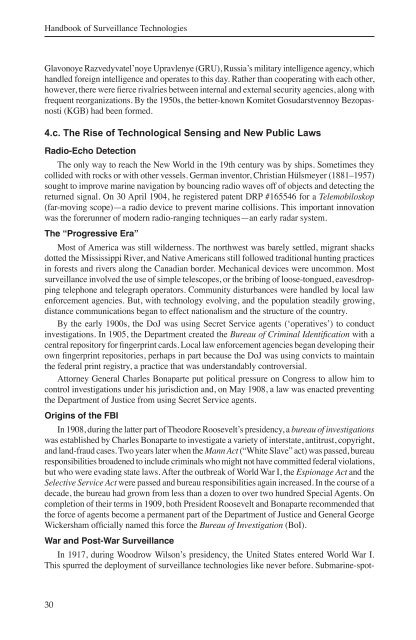Handbook of Surveillance Technologies (3rd Ed) - The Real Faces of ...
Handbook of Surveillance Technologies (3rd Ed) - The Real Faces of ...
Handbook of Surveillance Technologies (3rd Ed) - The Real Faces of ...
You also want an ePaper? Increase the reach of your titles
YUMPU automatically turns print PDFs into web optimized ePapers that Google loves.
<strong>Handbook</strong> <strong>of</strong> <strong>Surveillance</strong> <strong>Technologies</strong><br />
Glavonoye Razvedyvatel’noye Upravlenye (GRU), Russia’s military intelligence agency, which<br />
handled foreign intelligence and operates to this day. Rather than cooperating with each other,<br />
however, there were fierce rivalries between internal and external security agencies, along with<br />
frequent reorganizations. By the 1950s, the better-known Komitet Gosudarstvennoy Bezopasnosti<br />
(KGB) had been formed.<br />
4.c. <strong>The</strong> Rise <strong>of</strong> Technological Sensing and New Public Laws<br />
Radio-Echo Detection<br />
<strong>The</strong> only way to reach the New World in the 19th century was by ships. Sometimes they<br />
collided with rocks or with other vessels. German inventor, Christian Hülsmeyer (1881–1957)<br />
sought to improve marine navigation by bouncing radio waves <strong>of</strong>f <strong>of</strong> objects and detecting the<br />
returned signal. On 30 April 1904, he registered patent DRP #165546 for a Telemobiloskop<br />
(far-moving scope)—a radio device to prevent marine collisions. This important innovation<br />
was the forerunner <strong>of</strong> modern radio-ranging techniques—an early radar system.<br />
<strong>The</strong> “Progressive Era”<br />
Most <strong>of</strong> America was still wilderness. <strong>The</strong> northwest was barely settled, migrant shacks<br />
dotted the Mississippi River, and Native Americans still followed traditional hunting practices<br />
in forests and rivers along the Canadian border. Mechanical devices were uncommon. Most<br />
surveillance involved the use <strong>of</strong> simple telescopes, or the bribing <strong>of</strong> loose-tongued, eavesdropping<br />
telephone and telegraph operators. Community disturbances were handled by local law<br />
enforcement agencies. But, with technology evolving, and the population steadily growing,<br />
distance communications began to effect nationalism and the structure <strong>of</strong> the country.<br />
By the early 1900s, the DoJ was using Secret Service agents (‘operatives’) to conduct<br />
investigations. In 1905, the Department created the Bureau <strong>of</strong> Criminal Identification with a<br />
central repository for fingerprint cards. Local law enforcement agencies began developing their<br />
own fingerprint repositories, perhaps in part because the DoJ was using convicts to maintain<br />
the federal print registry, a practice that was understandably controversial.<br />
Attorney General Charles Bonaparte put political pressure on Congress to allow him to<br />
control investigations under his jurisdiction and, on May 1908, a law was enacted preventing<br />
the Department <strong>of</strong> Justice from using Secret Service agents.<br />
Origins <strong>of</strong> the FBI<br />
In 1908, during the latter part <strong>of</strong> <strong>The</strong>odore Roosevelt’s presidency, a bureau <strong>of</strong> investigations<br />
was established by Charles Bonaparte to investigate a variety <strong>of</strong> interstate, antitrust, copyright,<br />
and land-fraud cases. Two years later when the Mann Act (“White Slave” act) was passed, bureau<br />
responsibilities broadened to include criminals who might not have committed federal violations,<br />
but who were evading state laws. After the outbreak <strong>of</strong> World War I, the Espionage Act and the<br />
Selective Service Act were passed and bureau responsibilities again increased. In the course <strong>of</strong> a<br />
decade, the bureau had grown from less than a dozen to over two hundred Special Agents. On<br />
completion <strong>of</strong> their terms in 1909, both President Roosevelt and Bonaparte recommended that<br />
the force <strong>of</strong> agents become a permanent part <strong>of</strong> the Department <strong>of</strong> Justice and General George<br />
Wickersham <strong>of</strong>ficially named this force the Bureau <strong>of</strong> Investigation (BoI).<br />
War and Post-War <strong>Surveillance</strong><br />
In 1917, during Woodrow Wilson’s presidency, the United States entered World War I.<br />
This spurred the deployment <strong>of</strong> surveillance technologies like never before. Submarine-spot-<br />
30



